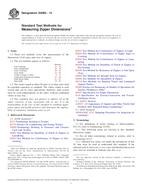We need your consent to use the individual data so that you can see information about your interests, among other things. Click "OK" to give your consent.
ASTM D2060-14
Standard Test Methods for Measuring Zipper Dimensions
STANDARD published on 1.2.2014
The information about the standard:
Designation standards: ASTM D2060-14
Note: WITHDRAWN
Publication date standards: 1.2.2014
SKU: NS-19162
The number of pages: 9
Approximate weight : 27 g (0.06 lbs)
Country: American technical standard
Category: Technical standards ASTM
Annotation of standard text ASTM D2060-14 :
Keywords:
dimension, zipper, ICS Number Code 61.040 (Headgear. Clothing accessories. Fastening of clothing)
Additional information
| Significance and Use | ||||||||||||||||||||||||||||||||||||||||||||||||||
|
4.1 The significance of specific tests is discussed in the appropriate sections. 4.2 These test methods are considered satisfactory for acceptance testing of commercial shipments because the test methods have been used extensively in the trade for this purpose, and because current estimates of between-laboratory precision are acceptable in most cases. 4.2.1 In case of a dispute arising from differences in reported test results when using Test Methods D2060 for acceptance testing of commercial shipments, the purchaser and the supplier should conduct comparative tests to determine if there is a statistical bias between their laboratories. Competent statistical assistance is recommended for the investigation of bias. As a minimum, the two parties should take a group of test specimens that are as homogeneous as possible and that are from a lot of material of the type in question. The test specimens should then be randomly assigned in equal numbers to each laboratory for testing. The average results from the two laboratories should be compared using Student's t-test for unpaired data and an acceptable probability level chosen by the two parties before the testing is begun. If a bias if found, either its cause must be found and corrected or the purchaser and the supplier must agree to interpret future test results in the light of the known bias. 4.3 The test method(s) in these test methods, along with those in Test Methods D2051, D2052, D2053, D2054, D2057, D2058, D2059, D2061, and D2062, are a collection of proven test methods. They can be used as aids in the evaluation of zippers without the need for a thorough knowledge of zippers. The enumerated test methods do not provide for the evaluation of all zipper properties. Besides those properties measured by means of the enumerated test methods there are other properties that may be important for the satisfactory performance of a zipper. Test methods for measuring those properties have not been published either because no practical methods have yet been developed or because a valid evaluation of the information resulting from existing unpublished methods requires an intimate and thorough knowledge of zippers. |
||||||||||||||||||||||||||||||||||||||||||||||||||
| 1. Scope | ||||||||||||||||||||||||||||||||||||||||||||||||||
|
1.1 These test methods cover the measurement of the dimensions of all types and sizes of zippers. 1.2 The test methods appear as follows:
We recommend:Updating of laws
Do you want to be sure about the validity of used regulations? Latest update: 2025-04-25 (Number of items: 2 197 372) |




 Cookies
Cookies
